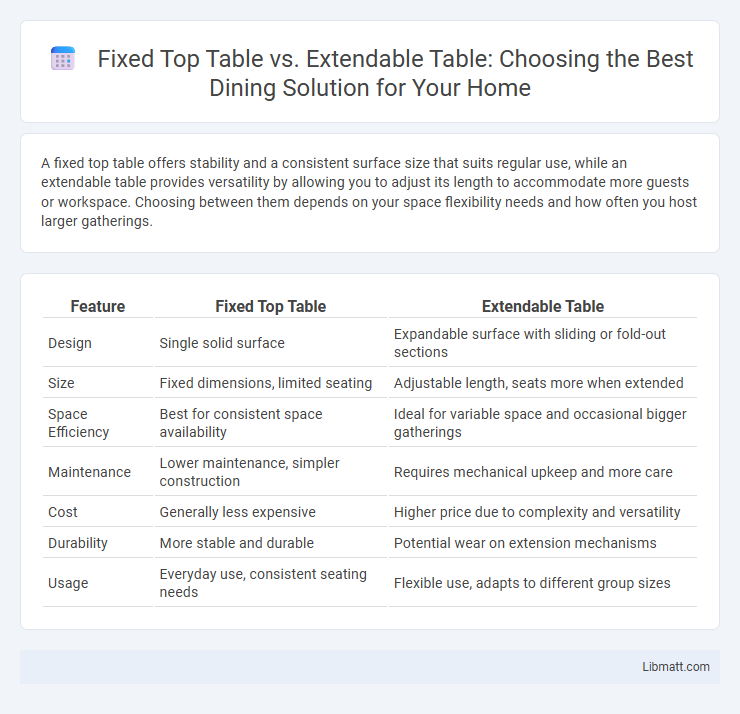A fixed top table offers stability and a consistent surface size that suits regular use, while an extendable table provides versatility by allowing you to adjust its length to accommodate more guests or workspace. Choosing between them depends on your space flexibility needs and how often you host larger gatherings.
Table of Comparison
| Feature | Fixed Top Table | Extendable Table |
|---|---|---|
| Design | Single solid surface | Expandable surface with sliding or fold-out sections |
| Size | Fixed dimensions, limited seating | Adjustable length, seats more when extended |
| Space Efficiency | Best for consistent space availability | Ideal for variable space and occasional bigger gatherings |
| Maintenance | Lower maintenance, simpler construction | Requires mechanical upkeep and more care |
| Cost | Generally less expensive | Higher price due to complexity and versatility |
| Durability | More stable and durable | Potential wear on extension mechanisms |
| Usage | Everyday use, consistent seating needs | Flexible use, adapts to different group sizes |
Introduction to Fixed Top and Extendable Tables
Fixed top tables feature a solid, immovable surface that offers durability and stability, ideal for consistent use in dining rooms or offices. Extendable tables provide adjustable surface area through fold-out leaves or sliding mechanisms, allowing flexibility for accommodating extra guests or workspace when needed. Understanding these key differences helps you select the right table to suit your space and functional requirements.
Key Differences Between Fixed and Extendable Tables
Fixed top tables offer a stable, unchanging surface ideal for consistent use in smaller spaces, while extendable tables provide flexibility by allowing you to adjust the size according to the number of guests. Key differences include the fixed table's compact design versus the extendable's ability to expand, making it suitable for larger gatherings or multifunctional rooms. Your choice depends on the space available and whether you prioritize permanence or adaptability in dining arrangements.
Advantages of Fixed Top Tables
Fixed top tables provide robust stability and durability, making them ideal for heavy-duty tasks and long-term use. Their solid construction prevents wobbling and ensures a consistent work surface, enhancing productivity and precision. Your workspace benefits from minimal maintenance and greater reliability compared to extendable tables, which may have moving parts prone to wear.
Advantages of Extendable Tables
Extendable tables offer superior versatility by allowing users to adjust the table size according to their needs, accommodating more guests during gatherings or providing a compact surface for everyday use. Their adjustable feature optimizes space efficiency in smaller rooms, making them ideal for apartments and multifunctional spaces. The ability to expand or contract also enhances functionality, enabling customization without sacrificing style or design continuity.
Space Efficiency: Which Table Wins?
A fixed top table offers consistent workspace dimensions, making it ideal for small areas where space optimization is crucial. Extendable tables provide flexibility by expanding to accommodate more people when needed, but they require additional room when extended, reducing space efficiency in compact rooms. Your choice depends on prioritizing either constant space-saving or adaptable usage for varying needs.
Durability and Maintenance Considerations
Fixed top tables often feature solid construction with fewer moving parts, resulting in enhanced durability and lower maintenance requirements over time. Extendable tables incorporate mechanisms and joints that may require regular lubrication and adjustments to maintain smooth operation and structural integrity. Choosing between the two depends on prioritizing long-term sturdiness with minimal upkeep (fixed top) versus flexibility that demands periodic maintenance (extendable).
Style and Design Versatility
A fixed top table offers a classic, streamlined design that fits seamlessly into traditional or minimalist interiors, providing stability and a consistent aesthetic. In contrast, an extendable table enhances design versatility by adapting to various space requirements and occasions, allowing you to customize its size without compromising on style. Choosing between them depends on your need for flexibility versus a permanent, cohesive look in your decor.
Cost Comparison: Fixed vs Extendable Tables
Fixed top tables generally incur lower initial costs due to simpler design and less material use compared to extendable tables. Extendable tables, featuring adjustable components and mechanisms, typically result in higher manufacturing and maintenance expenses. Over time, the versatility of extendable tables may offset their higher cost by accommodating varying space and seating needs, providing better long-term value despite the increased upfront investment.
Choosing the Right Table for Your Home
Fixed top tables offer durability and stability, making them ideal for smaller spaces or areas with a consistent seating requirement. Extendable tables provide versatile seating options, perfect for accommodating guests and maximizing space during gatherings. Selecting the right table depends on your home's layout, frequency of use, and need for flexibility in dining arrangements.
Final Thoughts: Fixed Top vs Extendable Tables
Fixed top tables offer stability and a consistent surface ideal for daily use, while extendable tables provide versatile space management for accommodating guests or varying needs. Your choice depends on balancing regular usage with flexibility; fixed tables suit smaller spaces with limited variability, whereas extendable options enhance adaptability without sacrificing style. Consider your lifestyle and dining habits to determine which table best fits your home environment.
Fixed top table vs extendable table Infographic

 libmatt.com
libmatt.com